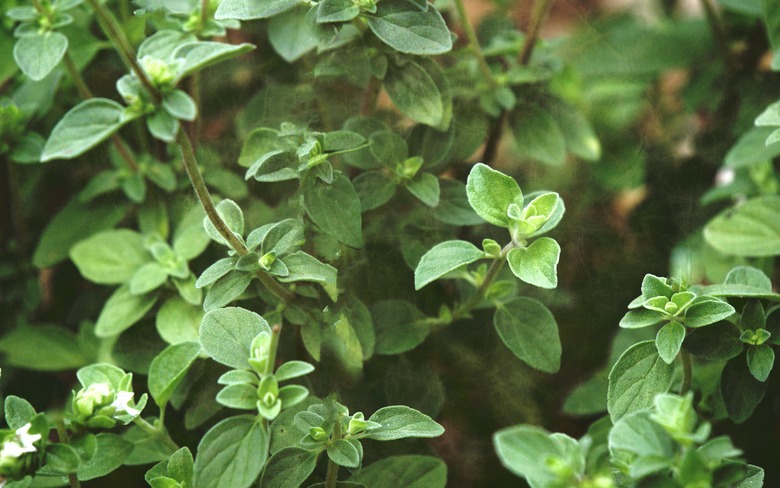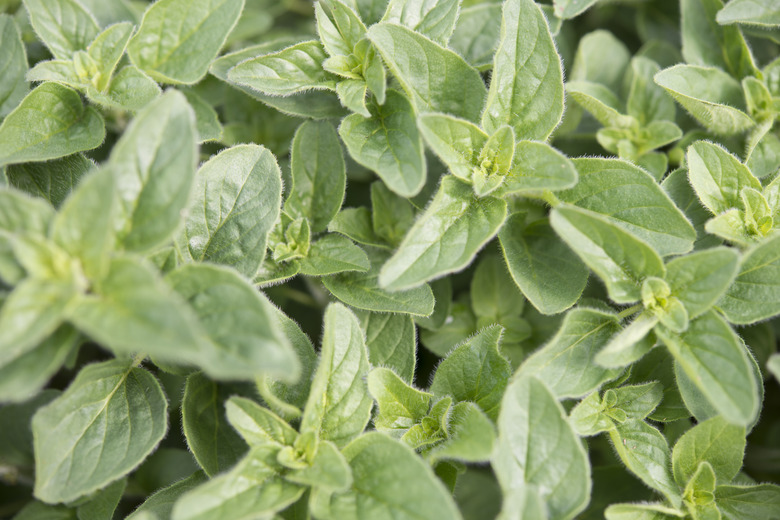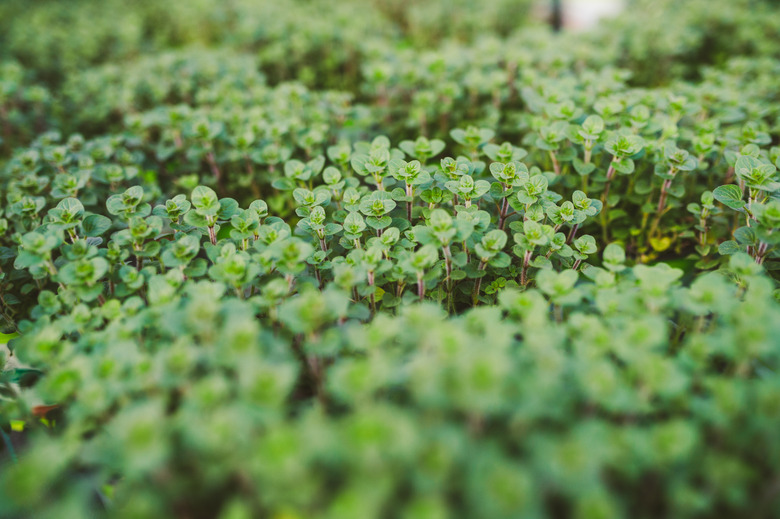How To Grow Oregano
A mainstay of Mediterranean-based cuisine — especially Italian and Greek food — oregano (Origanum vulgare, USDA zones 4-8) is among the most popular culinary herbs. It originated in Greece, but it is now grown all over the world. Oregano leaves are equally savory whether they're used fresh from the garden or dried.
This perennial herb has small green leaves, which provide an earthy flavor that is slightly bitter. From midsummer into fall, the plant produces small purple, rose or white flowers. Oregano is one of the easiest herbs to grow. It can be started from seeds in seed trays, sown directly into the garden, or started from cuttings. The seeds germinate in a few weeks, and once established, the plant requires little attention and can easily tolerate periods of drought, perfect for the novice gardener who wants good results without too much effort.
How to Grow Oregano
Planting Oregano From Seed
- For sowing directly into the garden soil, wait until outside temperatures are consistently above 45 degrees Fahrenheit to plant.
- Choose a spot in the garden that receives full sun and has soil that drains well. Prepare the planting bed by working organic matter, such as compost, into the top 6 to 8 inches of soil.
- Plant oregano seeds in shallow holes and cover with about 1/4 inch of soil.
- Keep the soil moist. The seedlings will germinate in 10 to 21 days.
- When seedlings are a few inches high and have three sets of leaves on the stem, thin so that plants are about 12 inches apart.
If you'd like get a head start before the ground warms up, sow oregano seeds indoors in seed trays or starter kits six to 10 weeks before the last spring frost date. Here's how to do it:
- Barely cover the seeds with soil and keep the soil moist and at about 70 degrees.
- Once seedlings appear in 10 to 21 days, provide plenty of light from a sunny window.
- When seedlings have developed three sets of leaves, transplant them into 4-inch pots filled with potting soil. This will help the roots develop before transplanting to the garden.
- About four weeks into the process, you can lightly fertilize the plants.
- Use fertilizer formulated for seedlings or a half dose of balanced fertilizer.
Oregano, like most plants started indoors, requires a hardening-off period before transplanting to the garden. Place the plants in a sheltered outdoor location, such as a porch, for about a week. If there is a danger of frost, move the plants indoors. The hardening process toughens the plant's cell structure and helps prevent transplant shock. At planting time, place the plants about 12 inches apart in holes that are the size of the root ball. Firm the soil around the plant and water.
Planting Oregano As a Seedling
Although oregano can easily be started from seeds, many spring garden centers and home centers offer oregano and other herbs as seedlings or very young plants. Provided that the climate is right and the soil is prepared appropriately, these seedlings are ready for the garden or containers. Here's how to plant oregano from a seedling:
- For the garden, add organic matter to the garden bed in a sunny area.
- Plant the oregano in holes that are as large as the root ball.
- When you remove the plant from its original container, you may have to loosen the roots by lightly raking the root ball with your fingers or a hand trowel.
- Plants should be spaced about 12 inches apart.
In What Zone Does Oregano Grow Best?
Oregano thrives in hot weather. It can grow in USDA zones 4 or 5 through 8 or 9, but it actually behaves differently in the very warm areas of the country. Oregano is a perennial, and in the deep South, the plant is evergreen year-round. In colder areas, the plant should be cut back and covered with mulch to overwinter.
This is a hardy herb and really does not need any special protection from strong winds. As long as the plant gets six to eight hours of sun a day and is planted on soil that drains well, it will be fine.
When Should You Plant Oregano?
Never plant oregano outdoors until all danger of frost has passed. Some gardeners wait a few weeks after that to be confident that the weather will stay warm. To start seeds indoors, there is a six- to 10-week lag period between starting the seeds and the last frost date. That means in some parts of the country, you can get the seed starter trays ready around Valentine's Day.
Where to Plant Oregano
Oregano grows 12 to 24 inches high with an equal spread. It needs full sun to thrive, so any sunny spot where you can reach the plant to harvest its leaves will do.
Though you can certainly find a permanent space for oregano in your garden, planting it in pots and placing them on decks or patios keeps the herb within easy reach for cooking throughout the growing season. Simply snip off a stem of leaves once the plant is established. Conveniently, you can also bring container-grown plants inside during the winter. They will keep producing as long as you place them in a sunny spot.
Although the plant can reach a couple of feet in height, it can be trained to be a ground cover. By pinching young plants to within 2 inches of the ground, the plant will spread outward. A grouping of oregano plants will eventually weave together to form a dense ground cover.
There is no need to worry about the herbs or vegetables you plant near oregano because it gets along with practically all vegetables and herbs. Many gardeners plant it near tomatoes because though oregano does attract aphids, which are hazardous to tomatoes. However, oregano also attracts flower flies, which are beneficial insects because they are natural predators for aphids.
Soil, Sunlight, and Water Recommendations for Oregano
Soil that drains well is a must for oregano, but other than that, it isn't too fussy. The plants do best in soil that has a neutral pH of about 6 or 7. The pH is a measurement of soil balance — how acidic or alkaline it is on a scale of 1 to 14. You can have your soil tested at some garden centers or at your local cooperative extension service. You can also use a DIY soil test kit.
Soil that is rich in organic matter won't need much help from fertilizers throughout the growing season. You can apply a general-purpose fertilizer for herbs if the soil is lacking in essential nutrients.
The herb's Mediterranean heritage means oregano needs up to eight hours of sunlight a day. However, the plant can tolerate some shade, especially in the deep South during hot-weather months.
Oregano is drought -tolerant, and in most cases, natural rainfall is all that is required to keep the plants hydrated. Water garden-planted oregano deeply during dry spells. Container-planted oregano should be watered when the soil is dry to the touch. Water until the water runs out through the drainage holes in the container.
How to Propagate Oregano
Propagating oregano is a cinch. Here's how to do it:
- To start new plants, take a 5- or 6-inch tip cutting from an existing plant. Use clean, sharp scissors or shears.
- Make the cuts at an angle just below a leaf node. You can take the cutting at any time during the growing season, but those taken in the late spring or early summer will have the most pliable stems.
- Remove all of the leaves on the bottom two-thirds of the cutting but leave the leaves at the top of the stem in place. Stems generally root very easily, but to improve their chances of rooting, you can dip the bottom of the stem in a rooting hormone before pressing the stem in moist potting soil, firming the soil around the bottom of the stem.
- Make sure at least one leaf node is below the potting mix. If you place more than one stem in the same pot, make sure the leaves do not touch.
- Expose the unrooted cuttings to indirect light out of direct sun), and keep the soil lightly moist. The rooted plants can be moved outside when they show new growth and have a developed root system — a process that takes four to six weeks.
How to Winterize Oregano
Oregano is one of the perennial herbs that can overwinter in the ground across its hardiness zone range. In late fall after the first few hard frosts, cut back the plant to about 4 to 6 inches high. In the most Northern regions, cover the plants with a few inches of shredded bark mulch for extra protection.
You can also bring some plants indoors so that you can enjoy the harvest throughout the cold weather. Dig up the plants, taking as much of the root system as possible. Plant them in deep containers. Before bringing them indoors, do a reverse hardening off by placing the pots in a protected outdoor area for a few days. This will help the plants survive transplant shock. When they look healthy, place the plants in an indoor location where they will receive a lot of sun.
How to Harvest Oregano
If you are waiting until the end of the summer to harvest oregano, you are missing out on a lot of flavor. Use it throughout the growing season by snipping off leaves or stems once the plants are about 6 inches tall. Regular harvesting also promotes bushy growth. Many people believe the herb is at its most flavorful just before the flower buds form, which typically happens mid- to late summer.
You can dry oregano by tying cut stems together and hanging them in a dark, dry spot. Wrap the bundles in a perforated paper bag to catch the leaves that fall off. The dried herb will be ready in about four to six weeks. You can then remove the leaves and store them in glass jars. Some Italian cooks keep the bundles whole and remove the leaves when they are needed by holding the bundle over the food and tapping lightly.
Common Pests and Other Problems for Oregano
Oregano, like other plants, aren't without their pests. Here are what pests you should watch out for on your oregano plant:
- Aphids: These are tiny insects that feed on the underside of leaves, and can spell trouble for oregano plants.
- Spider mites: These pests also feed on the leaves, and they inject a toxin into the plant that can turn the leaves yellow. Spider mites are small and hard to spot, so it is important to inspect the plants regularly for these pests. You can remove them with a strong spray from a hose that you repeat daily until they are gone, or you can apply insecticidal soap.
- Leaf miners: These pests are the larvae of certain flies, and they can bore into oregano leaves to feed. You can spot them by the tan or brown trails they leave behind. Insecticides can't reach them when they are within the leaves, so the only recourse is to remove affected portions of the plant.
Common Diseases for Oregano
Although oregano is relatively hardy against diseases, it can be affected by certain fungal pathogens. To help prevent fungi from becoming established, follow advice on the seed packet or plant tag in regard to the planting and spacing of the plants. The best prevention is not overwatering and being sure to remove weeds and other debris from around your oregano plants.
Verticillium wilt lives in the soil and affects oregano plants through the root system. The leaves will begin to wilt and turn yellow. Rhizoctonia root rot turns the roots and stems black. In both cases, the only cure is to remove infected plants. Whatever you do, don't compost diseased plants, as this can spread disease through the compost.
Rust is another fungal disease that produces circular spots on the leaves. To remedy rusted leaves, remove affected portions of the plant.


